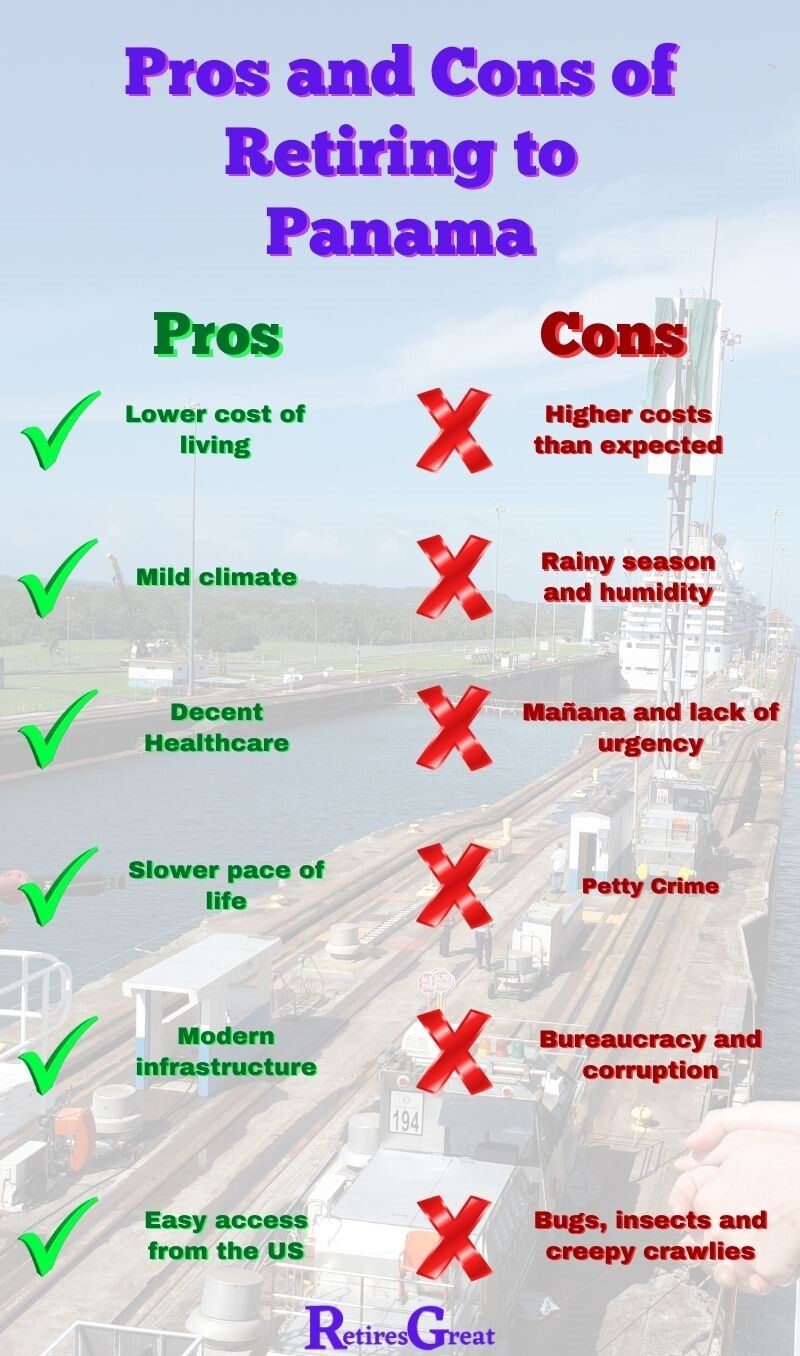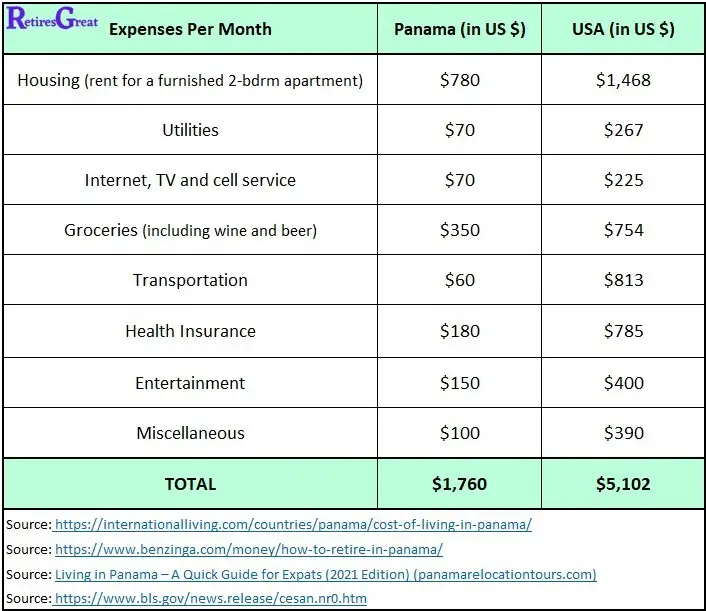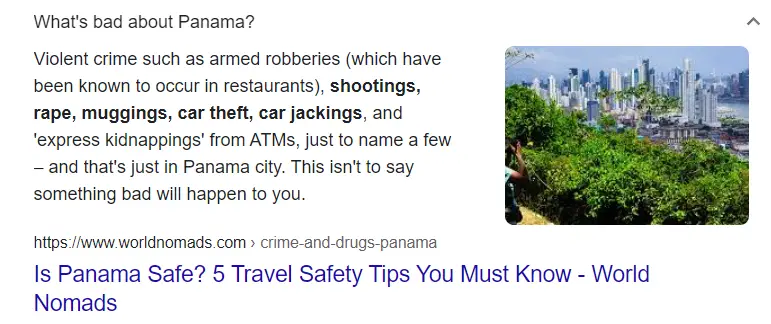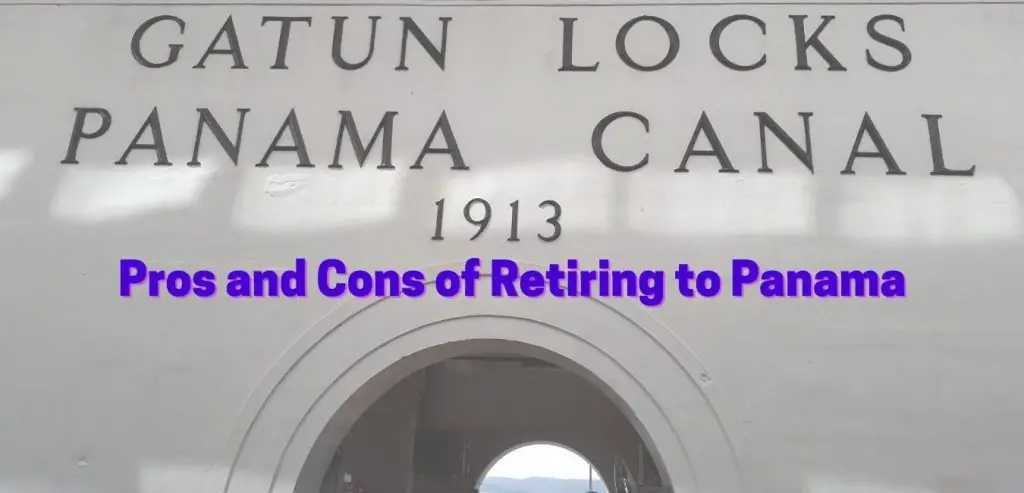Year after year, Panama is rated as one of the top retirement destinations. The lure is strong with 20,000 to 30,000 Americans already residing in this lush and beautiful country. Just as with anywhere else, there are advantages and disadvantages.
Pros and cons of retiring to Panama include:
Pros
Cons
Besides the lush green vegetation, the most notable feature is the iconic Panama Canal. Our article, facts about the Panama Canal, goes into greater detail.
Ongoing canal revenues have enabled a modern infrastructure of roadways, internet and cell phone coverage.
Panama isn’t a large country; only 40 miles across (at the canal). Total area is 29,157 square miles inhabited with a population of 4.3 million. Put into perspective, it’s slightly smaller than South Carolina with about 800,000 less residents.
With a favorable attitude toward Americans, a low cost of living, affordable healthcare and mild climate, this might be an ideal place to retire.

Compared to the U.S., the cost of living can be significantly less. According to Ceicdata, the average monthly income of Panamanians in 2020 was $1,185.
The table below shows expenses for the average expat couple compared to living in the US.

Pros
Certainly, you can live cheaply for a, more or less, comparable lifestyle. This is because major expenses such as housing, utilities, food and healthcare cost significantly less.
In fact, our findings in pros and cons of retiring in Costa Rica reveal the cost of living can even be slightly lower than there.
Another advantage is the currency. Both the Panamanian balboa and the US dollar are considered official currency and pegged at the same value.
This makes financial transactions straightforward with many US credit cards not charging extra fees. This also applies to wire transfers and using ATMs.
Pensionado Program
Panama values older residents and the Pensionado program provides unique benefits. To qualify, males need to be 60 years or older (females 55) with a pension exceeding $1,000.00. The many benefits include:
In addition, you’re entitled to a one-time exemption on importation of household goods up to $10,000 and tax exemptions on importing or purchasing a vehicle.
Cons
One caveat is the cost of living is highly dependent upon where you live and your desired lifestyle. For instance, living in an upscale neighborhood in Panama City will be significantly more expensive.
Mild Climate
Located 621 miles north of the equator, Panama has a warm tropical climate. The temperature fluctuates just a few degrees, depending on the month.
Likewise, sunrise and sunset remain constant (varying only a few minutes throughout the year) with almost 12 hours of daylight.
However, it rains and I mean a lot! The rainy season extends from mid-April until mid-December. You can expect daily afternoon/early evening deluges.
Thus, how you feel about this tropical climate will be a major factor in the pros and cons of retiring to Panama.
Pros
In coastal areas, the average daytime temperature is 86 °F (30 °C) with the evenings cooling down to 75 °F (24 °C). These temperatures remain remarkable consistent throughout the year, only fluctuating by a degree or two.
At higher elevations, such as in Boquete (at 3,700 feet), the days and evenings are more bearable. Typically, with daytime highs of 75 °F (24 °C) and the evenings around 55 °F (13 °C).
This alleviates the need for air conditioning, although the nights are definitely chillier.
Cons
If you enjoy the four seasons, this isn’t the place for you. The only change is the amount of precipitation. The interior and Caribbean side can get over 100 inches of annual rainfall.
In one respect, this is a good thing as it replenishes the water level of the canal. Having stated that, the rainy season can be dreary and overcast. The Pacific side is slightly drier with 50 – 70 inches of rain.
All this moisture translates to high humidity levels throughout the country. Even during the dry season, expect it to hover around 80%.
Decent Healthcare System
Affordable and decent healthcare is always an important consideration. According to the World Health Organization, Panama ranks 95th out of 191 countries. In comparison, neighboring Costa Rica ranked in 36th place.
The public healthcare system provided through the government is free to citizens and permanent residents. Surprisingly, even tourists arriving through Tocumen airport are eligible to use it during their first 30 days!
Some of the coverage includes:
The public healthcare system is basic and augmented by private healthcare. More affluent Panamanians and the majority of expats prefer the private system.
Even by local standards it’s inexpensive, with a visit to the doctor typically costing between $20 to $30.
The benefits of the private system include reduced wait times with higher levels of care. This in turn has created a booming medical tourism industry.
Anglo Info is a good source for more information on the healthcare systems.
Pros
The healthcare system is both high quality and relatively inexpensive. Nearly all the doctors speak English with many trained in the US.
Most medicines are inexpensive and available over the counter. However, the majority have different names so it’s wise to consult with a doctor. With the Pensionado Program, medical costs are further discounted.
Private health insurance is very affordable. As an example, a 66-year-old couple can expect to pay $180 per month with an annual $250 deductible. This ensures they’re covered in the event of any major medical expense.
Cons
The facilities and expertise are limited in rural areas. The hospitals are located in major centers and conduct almost all the specialized treatments and procedures.
Boquete doesn’t have a hospital and the nearest one is about 45 minutes away in David. If you needed more specialized care, the drive to Panama City is approximately 6 hours.
Unlike back home, there’s no country wide 911 service. In this respect, you’ll want to know who to call in an emergency. Another stumbling block will be for those who aren't fluent in Spanish.
Also, in an emergency situation, you might need to be airlifted. Depending upon your coverage, this could be a costly proposition.
Slower Pace of Life
As with most Latin American countries, the pace of life is slower without the urgency we’re used to back at home. Depending on your view point, you might consider this one of the pros and cons of retiring to Panama.
The Panamanian attitude is one of living life and you’ll hear them say “mañana”.
Roughly this translates to mean tomorrow. However, don’t hold your breath as it also could mean any day, except for today. Frustrating for sure when you need something done!
Pros
From my perspective, shedding all the hustle and bustle isn’t a bad thing. Panamanians are friendly and, if you can speak even a little Spanish, most will go out of their way to help.
Their culture is more about people and celebrating life. In fact, they love to party often going into the early hours of the morning.
The largest holiday is Carnaval, celebrating the four days preceding Ash Wednesday. You’re likely to see parades, decorated floats and street dancing. This is their version of Mardi Gras and a real celebration.
November includes five national holidays. Two of them are independence days (first one from Colombia, second one from Spain) and all include partying and fun. Don't expect to get much done during the month.
Cons
Government bureaucracy and ever-changing rules and/or interpretations appears to be an ongoing frustration. Numerous stories abound of expats requiring attorneys to resolve what should, otherwise, be straightforward issues.
Personal Safety and Crime in Panama
After visiting the country on multiple occasions, I’ve never felt at risk or in an unsafe situation. Compared to other Latin American countries, Panama is considered one of the safest.
However, due to economic disparity, almost a quarter of the population survive in poverty. This results in crimes of opportunity such as petty theft. In addition, some neighborhoods in the larger cities are more dangerous.

According to the Global Peace Index, Panama ranked 64th out of 163 countries. This highlights the need to remain aware of your surroundings and take necessary precautions.
In contrast, neighboring Costa Rica received a score of 32 and is deemed considerably safer.
Pros
While crime does exist throughout the country, in smaller cities and towns expats report feeling greater security with much less crime. Even so, many expats choose to reside in gated communities.
Cons
Corruption is another area of concern and Transparency International ranked Panama 111th out of 180 countries. Not a great score and you need to be aware of this systemic problem.
In fact, according to Statista, 16% of respondents identified they were asked or had to pay a bribe within the past 12 months.
For example, if you get pulled over for speeding, the police officer might hint they’ll let you off for $10. Seems like a good deal when the fine would be $58 and you’d have to stand in line to pay it. Yet, this further propagates an already corrupt system.
Ease of Access
Panama welcomes Americans and your passport would be stamped allowing you to stay for up to 180 days. This is referred to as a tourist visa which is perfect for escaping a cold winter while exploring this beautiful country.
With multiple flights from almost every major US airport, it’s easy to get there. The flight time from Miami is around 3 hours whereas Houston is just over 4.
Our post, advantages of retiring to Portugal, discusses numerous benefits; however, a short flight isn’t one of them.
If you decide this is where you want to retire, the residency process is straightforward. The Embassy of Panama outlines these steps in detail.
The processing and legal fees generally range between $3,000 and $5,000.
Modern Infrastructure
Revenues from the canal have helped upgrade infrastructure throughout the country. This has led to:
Even with all these investments, intermittent power outage still plagues some areas.
Other Interesting Things to Be Aware Of
Every country is different and Panama has some interesting differences.
Closing Thoughts on Pros and Cons of Retiring to Panama
Panama consistently ranks as one of the top retirement destinations for Americans. Based on my own experience, it’s a beautiful country filled with friendly people.
With a much lower cost of living, many expats report living comfortably on their Social Security alone.
Other benefits include quality health care, easy access from the states and a slower pace of life. While many retirees thrive in their new lifestyle, others not so much. The culture is different, it rains way too much and many miss family back home.
As this is a major life change, it’s highly recommended to live there 3 to 6 months before making any commitments. By then, most folks either fall in love with Panama or decide it’s not for them.

